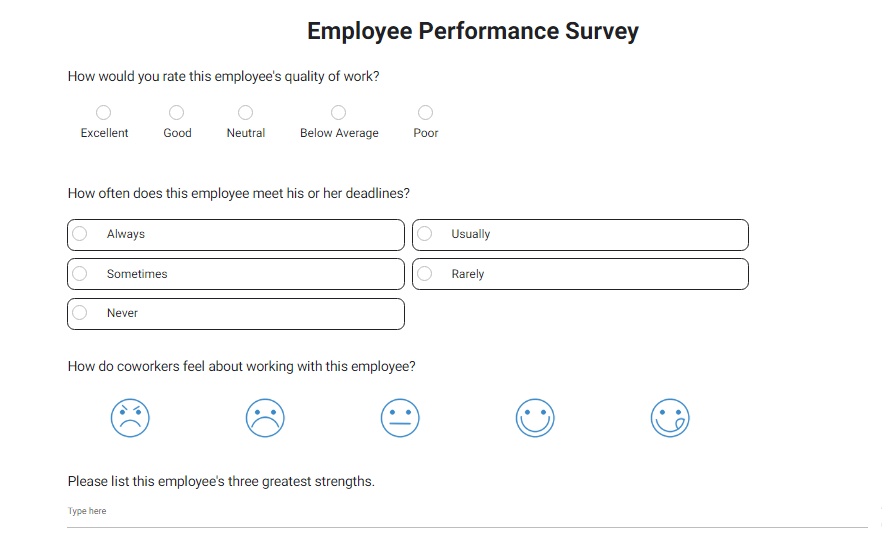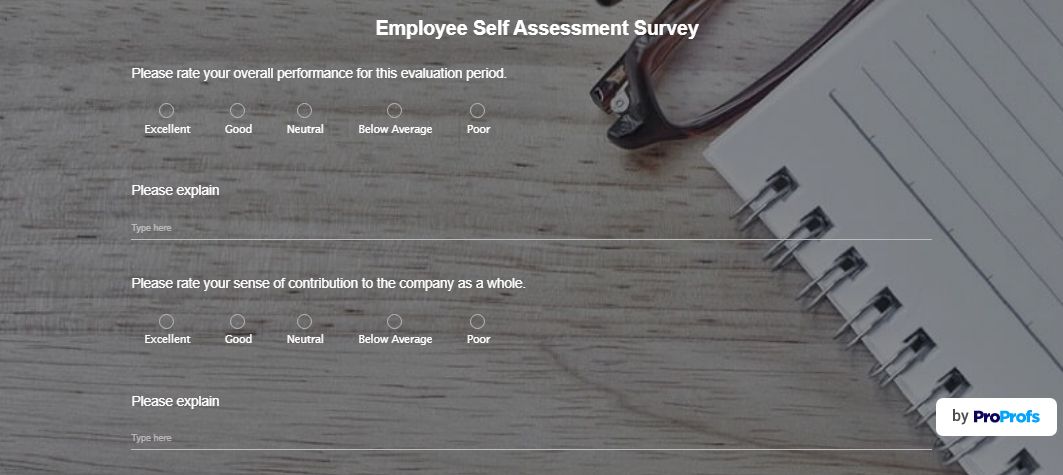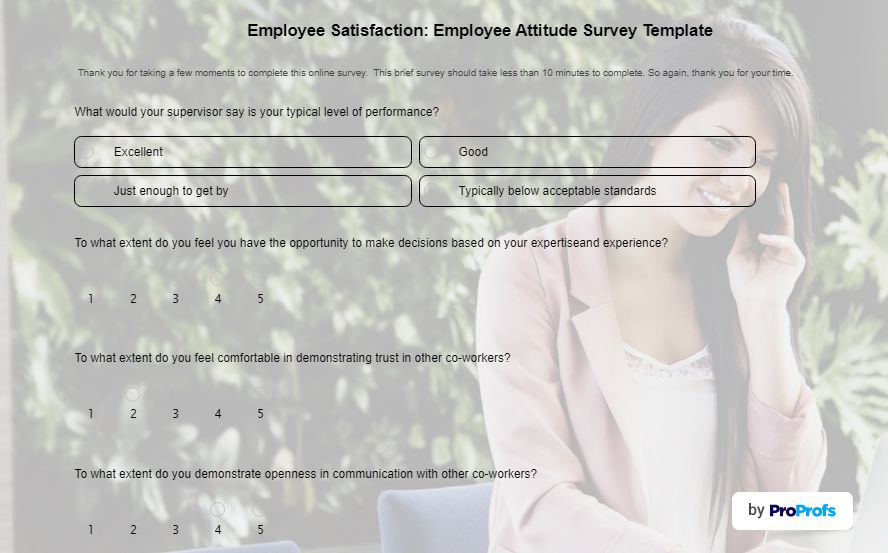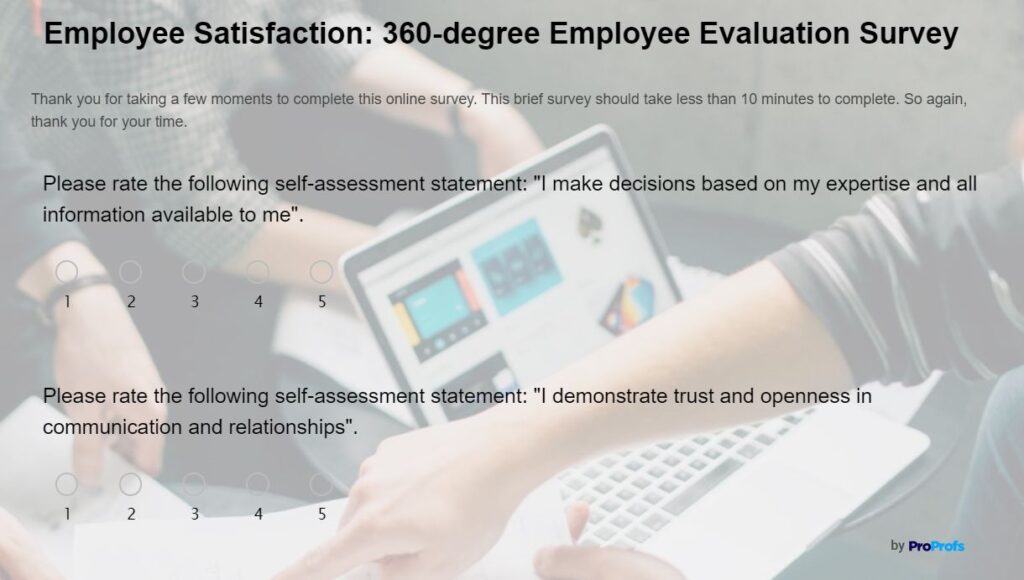
Performance assessments are crucial for organizations to measure employee effectiveness, provide feedback, and foster growth.
According to Gallup, companies that provide continuous strength-based feedback can reduce turnover by almost 15%, while 92% of people believe that constructive criticism effectively improves performance.
In this blog, we will explore the importance of employee evaluations, share best practices, and provide valuable insights on implementing effective evaluation processes.
What to Include In an Employee Evaluation Form?
To conduct a thorough and effective employee evaluation, ensuring that the evaluation process is comprehensive, objective, and aligned with organizational goals is cruical.
Here are the key sections to include in an employee evaluation form:
- Employee Information: Begin by capturing basic employee details such as name, job title, department, and the period covered by the evaluation.
- Performance Goals: Include a section to outline the performance goals that were set for the employee during the evaluation period. This can be a combination of individual, departmental, and organizational objectives.
- Job Responsibilities: Detail the employee’s key job responsibilities and core competencies. This section should clearly outline the expectations and standards for each area of responsibility.
- Performance Assessment: Provide a structured and detailed assessment of the employee’s performance in each area of responsibility. Use clear and measurable criteria to rate their performance, such as a numerical scale or descriptive phrases
- Achievements and Accomplishments: Allow space to document the employee’s noteworthy achievements and contributions during the evaluation period. This could include exceeding targets, implementing innovative ideas, or demonstrating exceptional teamwork.
- Areas for Improvement: Identify areas where the employee can improve their skills, knowledge, or performance. Provide constructive feedback and suggestions for development opportunities that can help them enhance their capabilities.
- Training and Development Needs: Assess the employee’s training and development needs based on their current performance and future goals. This can include technical skills, soft skills, or specific certifications that may be beneficial for their career growth.
- Self-Assessment: Allocate a section for the employee to assess their own performance and provide self-reflection. This serves as an opportunity for them to highlight their achievements, identify areas for improvement, and provide additional insights.
- Supervisor Comments: Allow the supervisor or evaluator to provide detailed feedback on the employee’s performance, acknowledging strengths and addressing areas that need improvement.
- Development Plan: Collaboratively establish a development plan with the employee, focusing on their career aspirations, areas for improvement, and goals for the next evaluation period. This could include training programs, mentoring, or additional responsibilities.
- Signatures: Include a section for both the employee and the supervisor to sign and date the evaluation form, indicating their acknowledgment and agreement on the evaluation outcomes.
What Are the Benefits of Employee Evaluation?
Employee evaluation is a valuable process that brings numerous benefits to both organizations and employees, such as:
1. Performance Measurement
Employee evaluations provide a structured framework for assessing an individual’s performance. By setting performance goals, evaluating progress, and providing feedback, evaluations enable organizations to measure and track the productivity and effectiveness of their employees.
This also helps in identifying high performers, as well as those who may need additional support or improvement.
2. Feedback and Development
Regular evaluations offer a platform for meaningful feedback and open communication between supervisors and employees. Constructive feedback highlights strengths to be celebrated and areas for improvement.
This feedback is crucial for employee development, helping them gain insights into their performance and facilitating personal and professional growth.
3. Identifying Training Needs
Employee evaluations help identify knowledge or skill gaps that may hinder performance. By assessing individual competencies and performance levels, organizations can identify specific training needs and design targeted development programs.
4. Goal Alignment
Evaluations allow for the alignment of individual goals with broader organizational objectives. By setting clear performance goals, employees understand how their work directly impacts the organization’s success. Evaluations help in monitoring progress toward these goals, making necessary adjustments, and encouraging employees to contribute to the overall success of the organization.
5. Recognition and Rewards
Employee evaluations provide an opportunity to recognize and reward outstanding performance. By acknowledging and appreciating their efforts, organizations can boost employee morale and motivation.
Recognizing achievements in evaluations also reinforces positive behaviors and cultivates a culture of continuous improvement, inspiring employees to strive for excellence.
6. Succession Planning and Talent Management
Evaluations play a crucial role in succession planning and talent management. By assessing employee competencies, identifying potential leaders, and recognizing high-potential talent, organizations can effectively plan for future leadership roles. Evaluations help in nurturing and retaining top performers, ensuring a pipeline of skilled and capable employees who can take on key positions when needed.
7. Performance Improvement and Accountability
Evaluations serve as a mechanism to address and improve any performance-related issues. By identifying areas where employees may be struggling or falling short, evaluations provide an opportunity to address these issues through discussions, training, mentoring, or coaching. You can integrate mentoring programs, which will help track progress over time, improve communication, connect your team with different mentors and overall make the training process more effective.
Employee Evaluation Question Examples
Employee evaluations often consist of various categories or sections, each focusing on specific aspects of an employee’s performance.
Here are some common categories and examples of employee evaluation questions within each category:
1. Job Performance
- How well does the employee meet their job responsibilities and deliver on tasks and assignments?
- How effectively does the employee manage their time and prioritize tasks?
- Does the employee consistently meet deadlines and achieve performance targets?
- How well does the employee handle pressure and adapt to changing work demands?
2. Communication and Collaboration
- How effectively does the employee communicate with colleagues, superiors, and clients?
- Does the employee actively listen and seek feedback from others?
- How well does the employee collaborate with team members and contribute to a positive working environment?
- Does the employee demonstrate strong interpersonal skills and the ability to resolve conflicts?
3. Quality of Work
- Does the employee consistently produce work that meets or exceeds expectations in terms of quality?
- How thorough and accurate are the employee’s work outputs?
- Is the employee proactive in identifying and resolving errors or issues in their work?
- Does the employee seek opportunities for improvement and innovation in their work?
4. Initiative and Problem-Solving
- Does the employee consistently demonstrate a proactive approach to their work?
- How effectively does the employee identify and solve problems?
- Does the employee take ownership of their work and seek opportunities to contribute beyond their assigned tasks?
- How well does the employee handle challenges and adapt to change?
5. Professional Development
- Has the employee shown a commitment to enhancing their skills and knowledge relevant to their role?
- Does the employee actively seek opportunities for professional growth and development?
- Has the employee participated in relevant training programs or pursued additional certifications?
- Does the employee demonstrate a willingness to learn from feedback and apply it to their work?
6. Leadership and Management
- If applicable, how effectively does the employee fulfill their leadership or managerial responsibilities?
- Does the employee demonstrate strong leadership qualities such as delegation, motivation, and coaching?
- How well does the employee manage and develop their team members?
- Does the employee effectively handle performance management and provide constructive feedback?
7. Goal Achievement
- Did the employee meet or exceed the goals and targets set for them during the evaluation period?
- Were the employee’s goals aligned with the organization’s overall objectives?
- Did the employee effectively track and measure their progress toward their goals?
- Did the employee actively seek support or resources needed to achieve their goals?
When to Conduct Employee Evaluation?
The frequency of employee evaluations ultimately depends on the needs and culture of the organization. However, make sure to strike the right balance between providing regular feedback and inducing survey fatigue – it is a fairly tight rope to walk on, indeed!
Regardless, here is a rundown of events when you can choose to assess your employees:
- Annual Evaluations: Annual evaluations are a common practice in many organizations. Conducting evaluations on an annual basis allows for a comprehensive review of an employee’s performance over a significant period, typically one year, as well as setting goals for the upcoming year.
- Probationary Period Evaluation: Probation is a time when an employee and the organization mutually determine whether they are suitable for a permanent position. Conducting evaluations at the end of this period provides an opportunity to assess whether the employee meets the required performance standards, demonstrates the necessary skills and competencies, and fits well within the organization’s culture.
- Quarterly or Mid-Year Evaluations: These evaluations are more frequent than annual reviews and offer a more regular and timely feedback loop, allowing for ongoing performance discussions and improvement opportunities. They can also help employees adapt and align their goals and performance based on changing business needs.
- Project-Based Evaluations: If you frequently assign employees to specific projects or tasks, conducting project-based evaluations makes sense. These evaluations take place at the conclusion of a project and focus on assessing the employee’s contributions, collaboration, problem-solving skills, and outcomes achieved.
- Manager-Requested Evaluations: Evaluations can also be conducted at the request of a manager or supervisor triggered by specific events such as a sudden decline in performance, frequent errors, or significant changes in job responsibilities.
- Promotion or Role Change Evaluations: When an employee is being considered for a promotion or a role change within the organization, conducting an evaluation can assess whether they are prepared and equipped to take on new challenges and contribute effectively in their new positions.
FREE. All Features. FOREVER!
Try our Forever FREE account with all premium features!
Employee Evaluation Form Templates
If you are new to creating employee evaluation forms, the idea of adding appropriate questions at the right number with the right tone can feel daunting.
To alleviate this, survey tools often include templates with readymade questions and themes. ProProfs Survey Maker is one of them, and here are the templates it offers for a complete, comprehensive employee evaluation at any given time.
Let’s explore!
1. Employee Performance Survey
This survey template focuses on assessing an employee’s performance in their role. It often includes questions related to job responsibilities, goal achievement, quality of work, and overall performance.

2. Employee Self Assessment
This survey template allows employees to evaluate their own performance and provide feedback on their accomplishments, strengths, weaknesses, and areas for improvement. It enables self-reflection and encourages employees to take ownership of their professional growth.

3. Employee Attitude
This survey template measures the attitudes, opinions, and job satisfaction levels of employees. It includes questions related to employee happiness, engagement, motivation, work-life balance, and the overall perception of the work environment.

4. 360-degree Employee Evaluation
A 360-degree evaluation involves gathering feedback from multiple sources, including supervisors, colleagues, and sometimes even subordinates. This survey template offers a comprehensive assessment of an employee’s performance, incorporating insights from individuals who interact with the employee in different capacities.

Assess Your Employees Effectively with Well-Crafted Employee Evaluation Forms
Effectively assessing employees is a critical practice for organizations to drive performance, productivity, and overall success. Well-crafted employee evaluation forms provide a structured framework for evaluating employee performance management, providing feedback, and identifying areas for development.
By considering the different types of evaluation forms and their purposes, you can tailor the evaluation process to their specific needs.
Get a demo or sign up for the free trial to create efficient employee evaluation forms hassle-free!
 Tips
Tips
We’d love to hear your tips & suggestions on this article!
FREE. All Features. FOREVER!
Try our Forever FREE account with all premium features!


 We'd love your feedback!
We'd love your feedback! Thanks for your feedback!
Thanks for your feedback!







